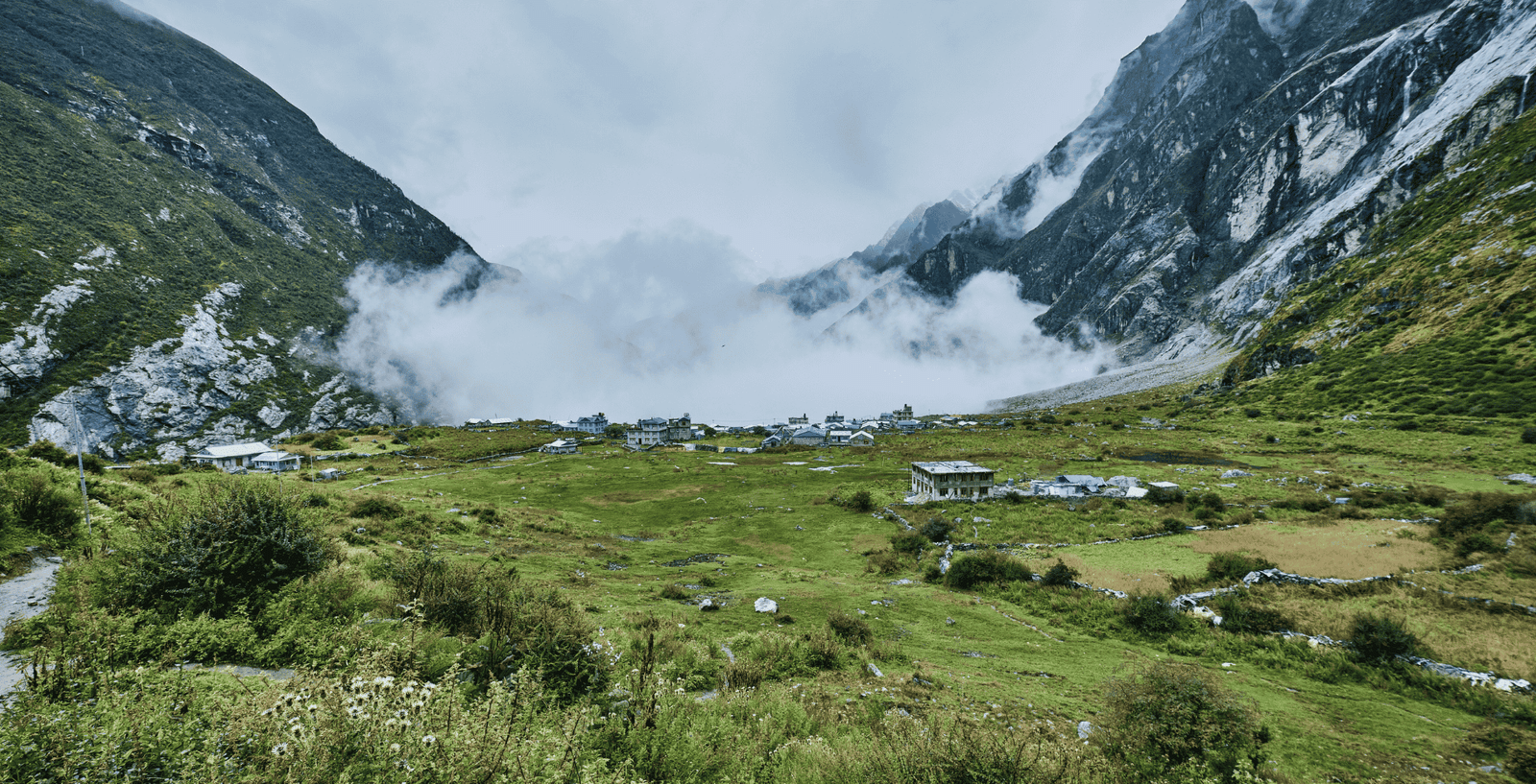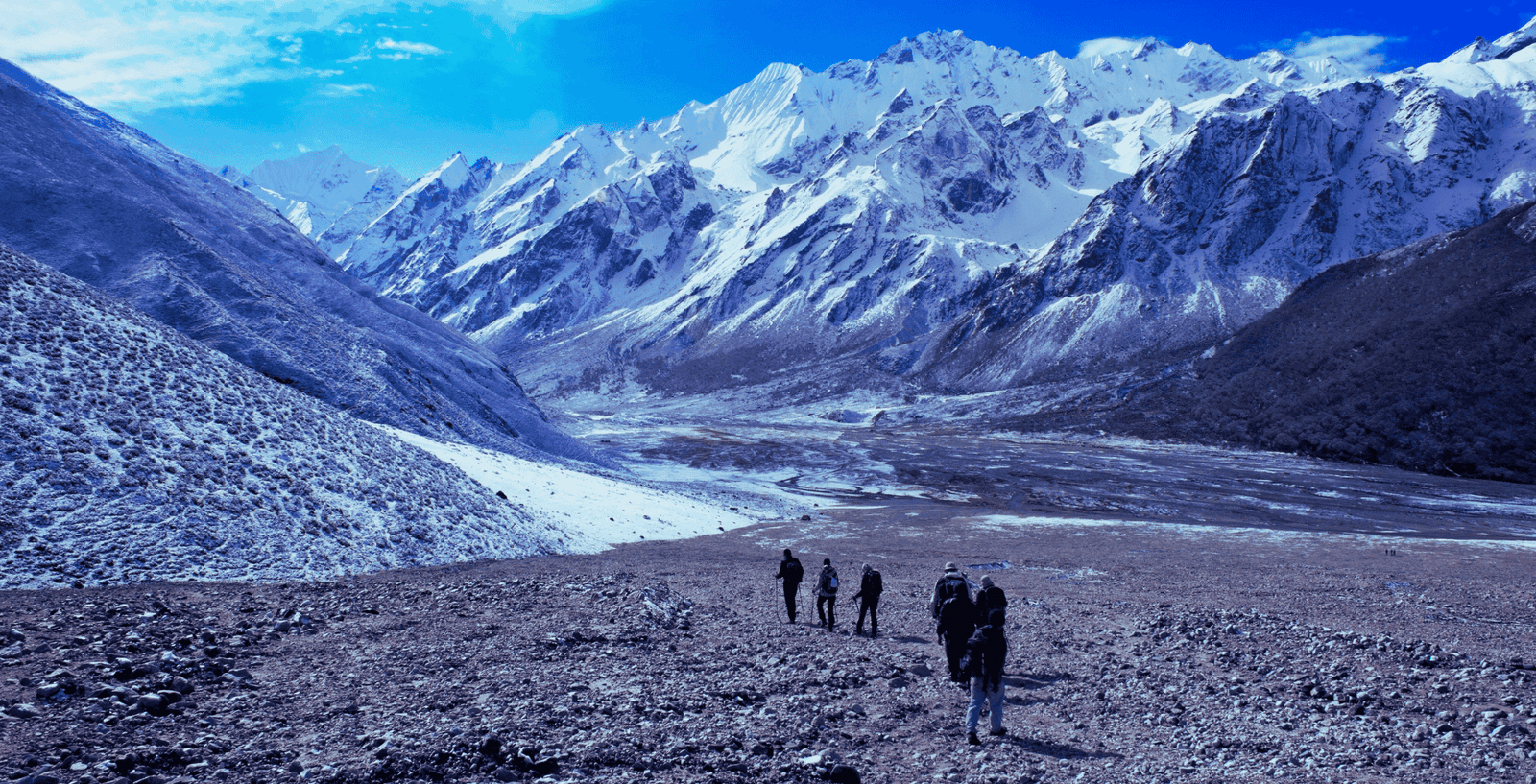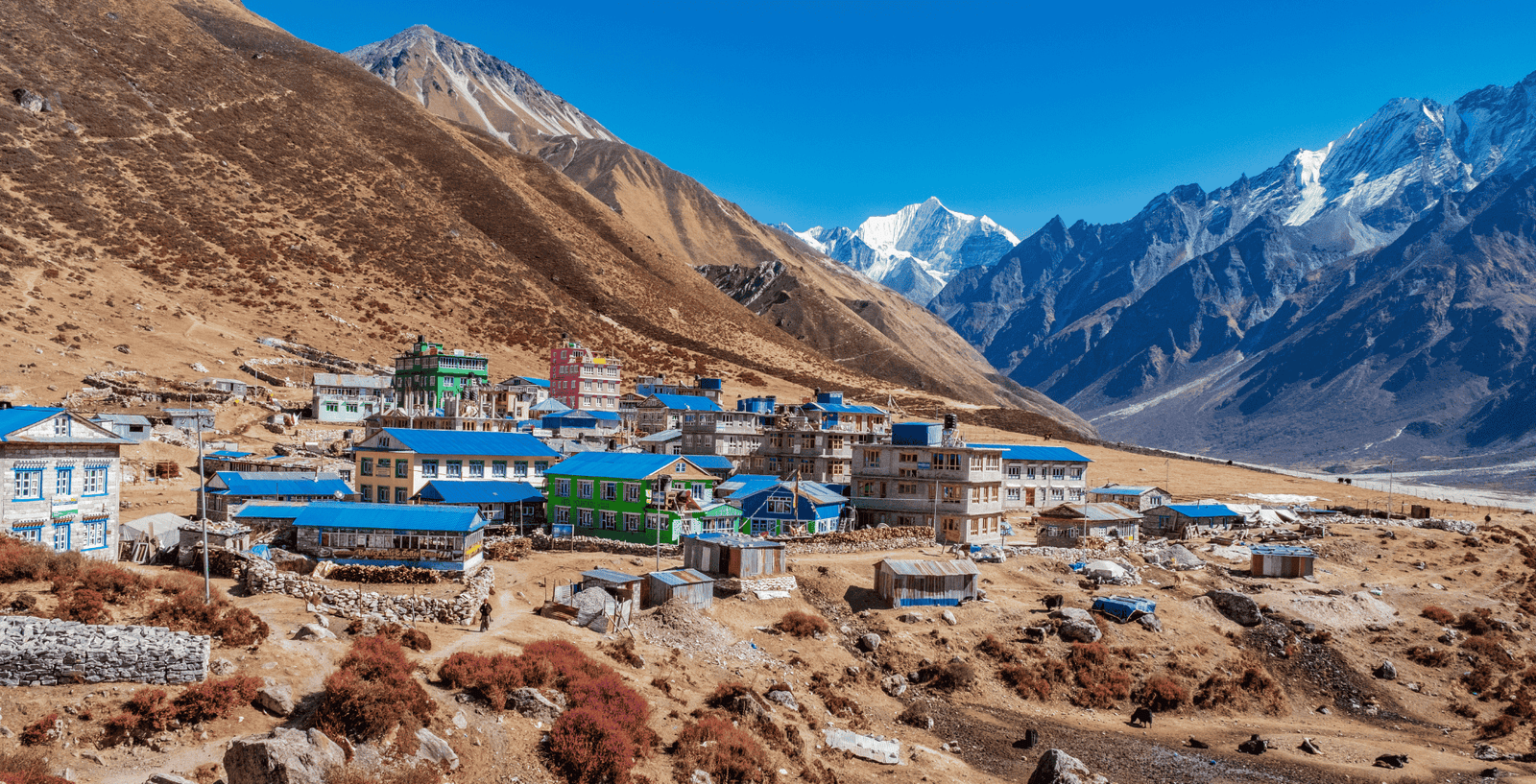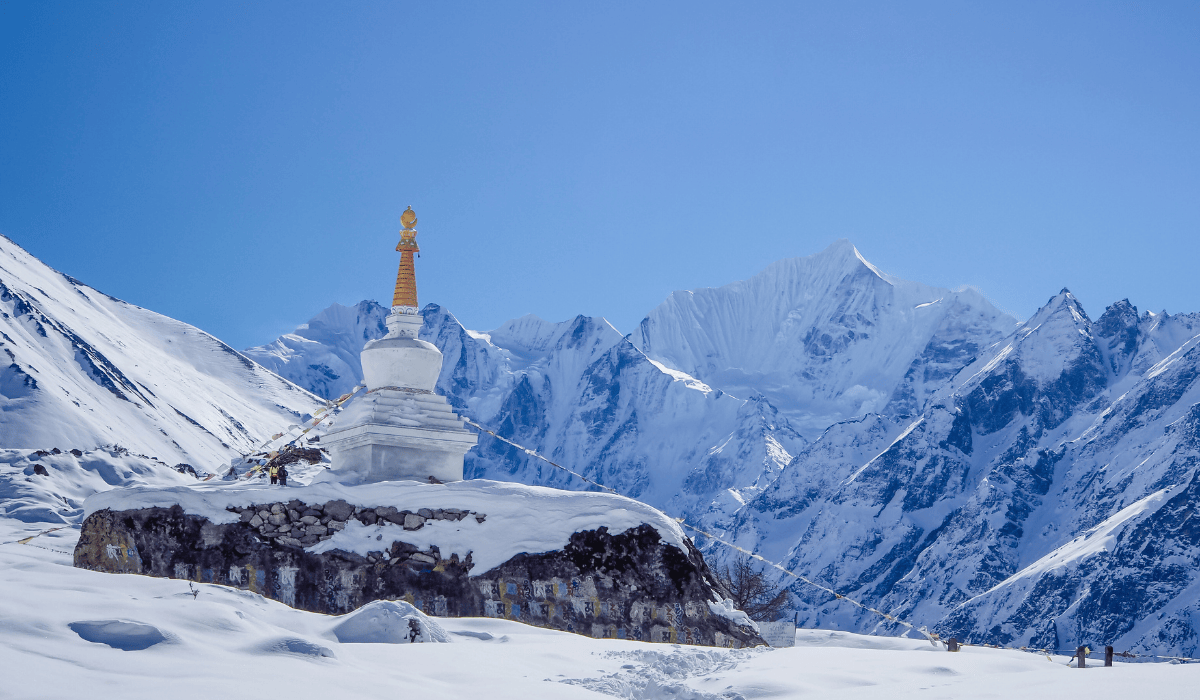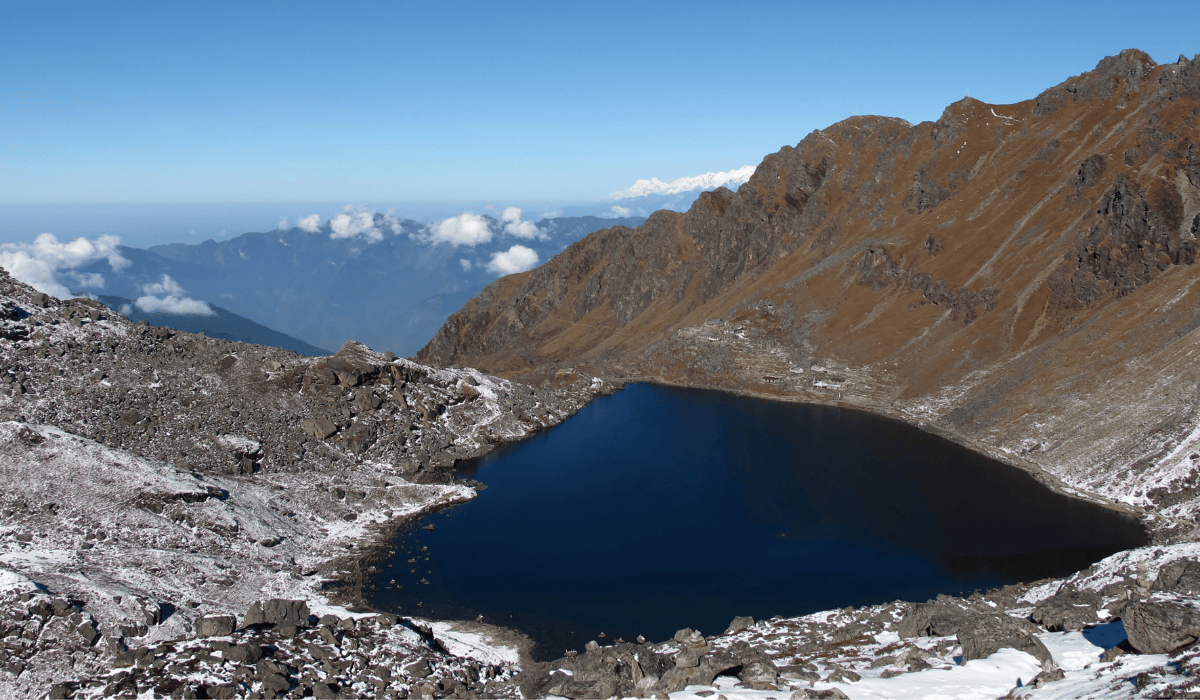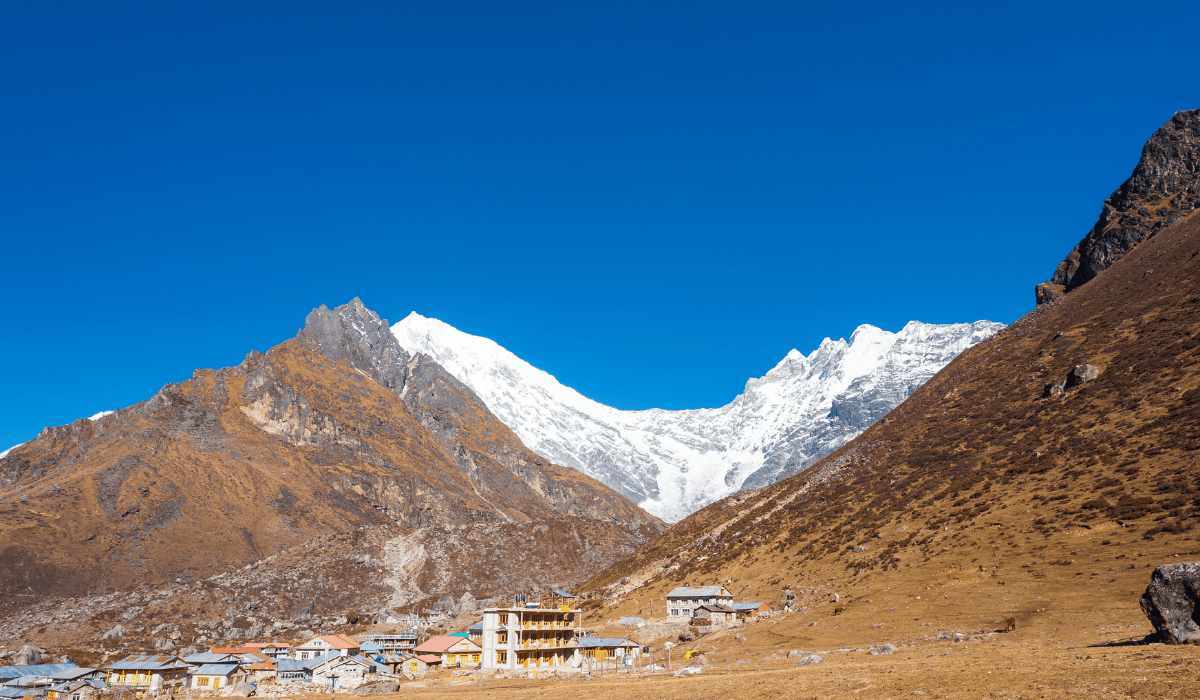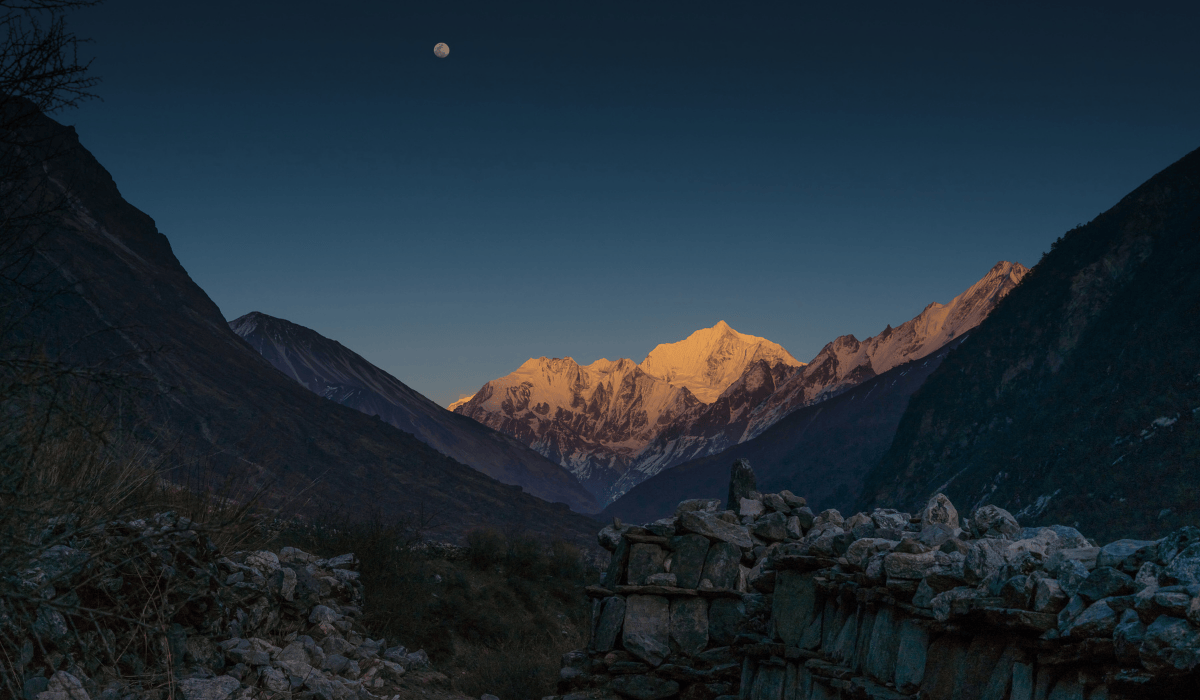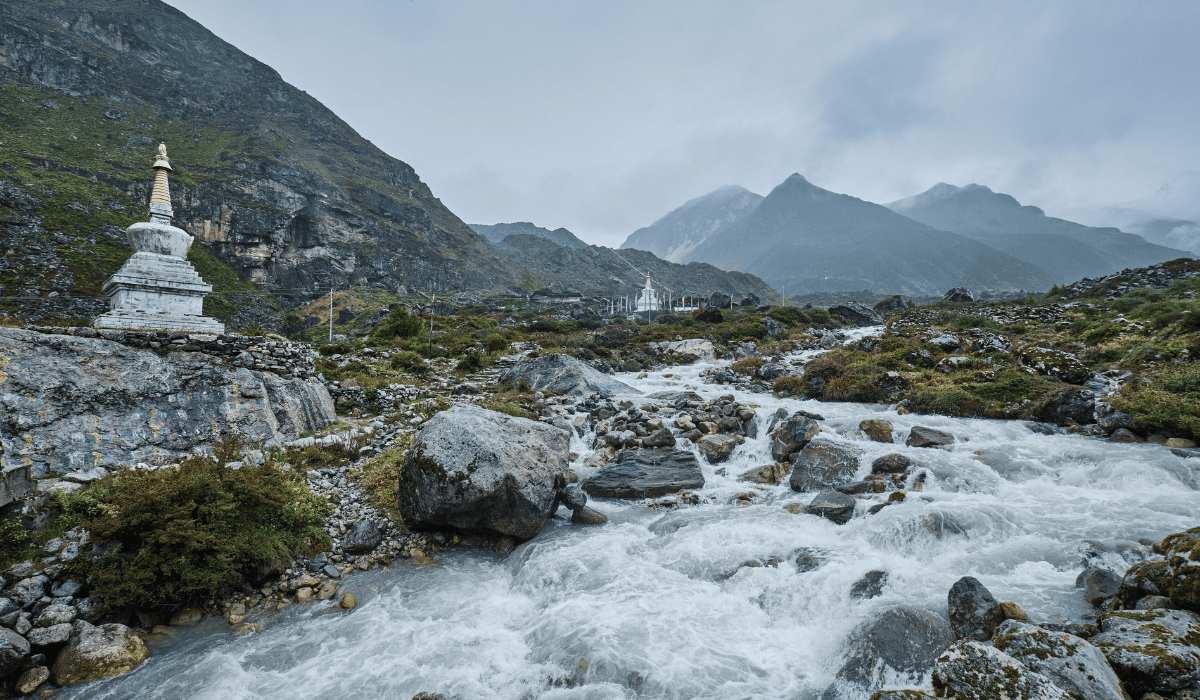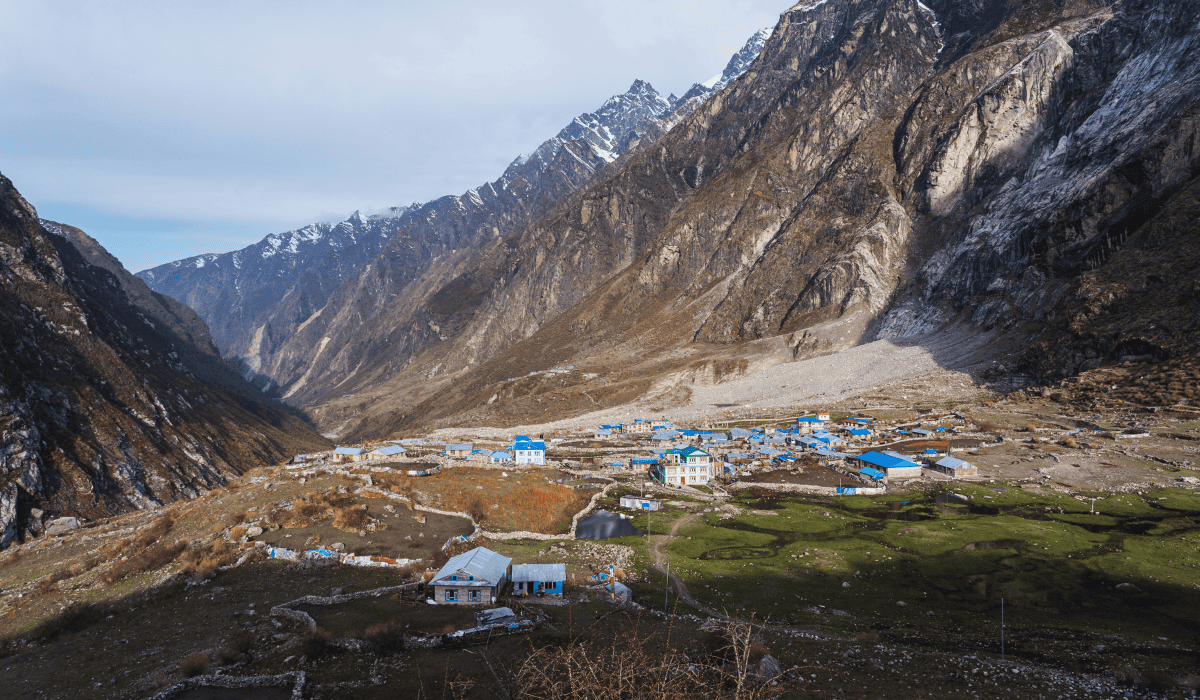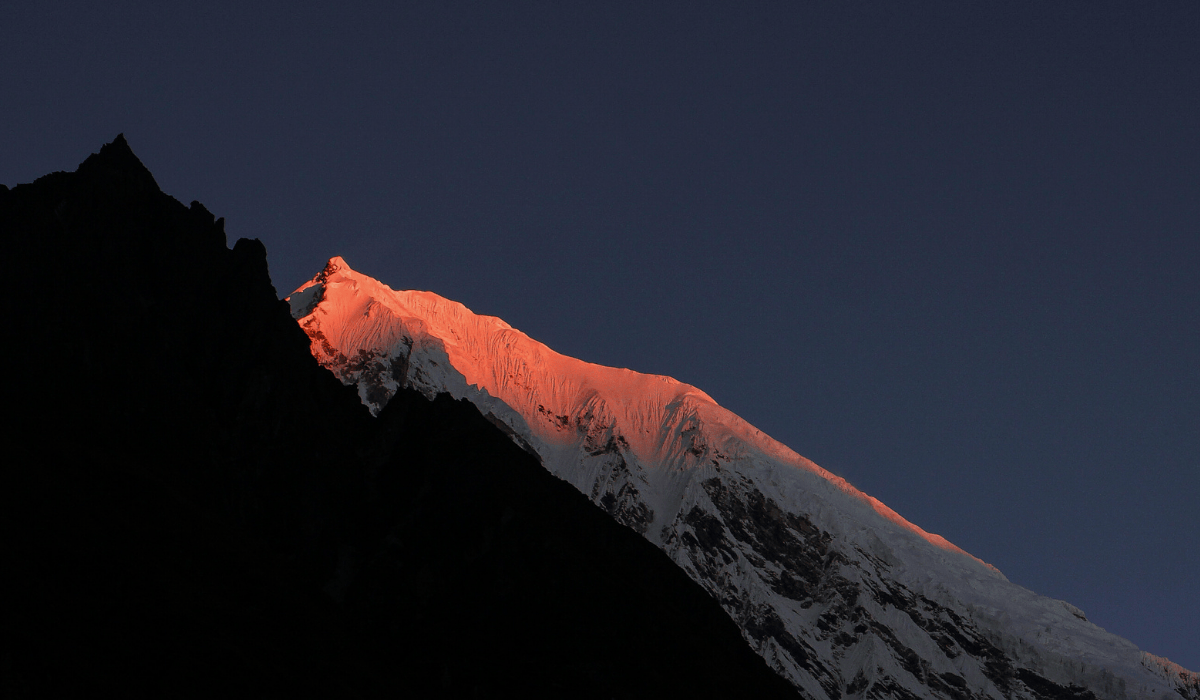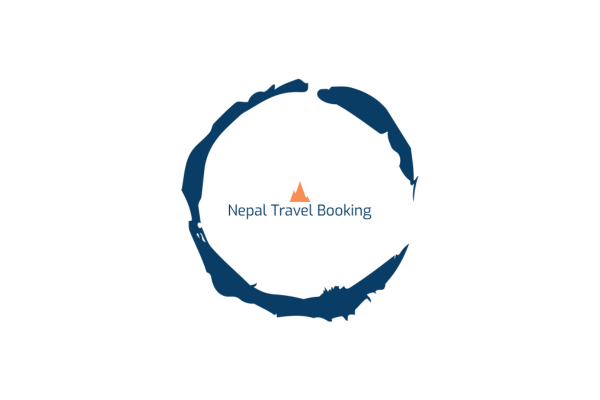The Langtang Valley, often referred to as "the valley of glaciers," is nestled amidst the breathtakingly beautiful mountains in the central Himalayan region of Nepal. Located approximately 61.8 kilometers north of the capital city, Kathmandu, the valley provides an enthralling spectacle of snow-clad peaks, lush green forests, and vibrant, traditional Nepalese villages.
The Langtang Valley lies within the boundaries of Langtang National Park, the first Himalayan national park of Nepal, established in 1976. The park spans over an area of 1,710 square kilometers, with diverse climatic zones that foster a rich variety of flora and fauna. It is home to several rare and endangered species like the red panda, Himalayan tahr, and snow leopard, making it a haven for wildlife enthusiasts.
At the heart of the valley are the Tamang people, an indigenous community whose culture, language, and dress are very similar to the Tibetan people. Their lifestyle, heavily influenced by Buddhism, reflects a symbiotic relationship with the natural environment, adding to the valley's distinct charm.
The Langtang Valley is also known for the Langtang Trek, one of the most popular trekking routes in Nepal. This trek, which ranges from moderately difficult to challenging, takes travelers through dramatic landscapes, ancient monasteries, and yak pastures, providing glimpses into the local culture and way of life. The trek ultimately leads to the high alpine valley where the stunning Langtang Lirung glacier and the Kyanjin Gompa, a famous Buddhist monastery, are located.
Despite being overshadowed by popular destinations like the Everest and Annapurna regions, Langtang Valley stands out as a hidden gem offering a blend of natural beauty, rich cultural heritage, and adventure. It's an unspoiled haven for those seeking tranquility away from the tourist crowds. Tragically, the valley was severely impacted by the devastating earthquake in 2015, but through resilience and community efforts, it has undergone considerable reconstruction and continues to welcome travelers from around the world.
What attracts travelers and trekkers?
Langtang Valley has long been a cherished destination for travelers and trekkers worldwide, thanks to its stunning natural beauty, rich cultural heritage, and the allure of adventure it offers. Here's a closer look at the appeal of Langtang Valley:
- Stunning Landscapes: Langtang Valley is often referred to as the "valley of glaciers" and for good reason. The region is abundant with snow-clad peaks, picturesque alpine forests, roaring rivers, and serene mountain lakes. The breathtaking views of peaks like Langtang Lirung, Ganesh Himal, and Dorje Lakpa are nothing short of awe-inspiring.
- Diverse Wildlife: The valley, which lies within Langtang National Park, is rich in biodiversity. The variation in altitude has resulted in a wide range of habitats, from deciduous forests to alpine scrub, making it home to numerous species, including the red panda, snow leopard, and Himalayan tahr. Bird enthusiasts can also spot a variety of bird species.
- Cultural Immersion: Langtang Valley is primarily inhabited by the Tamang ethnic group, whose culture, traditions, and lifestyle are heavily influenced by Tibetan Buddhism. The local architecture, monasteries, prayer flags, Mani walls, and the warmth of the Tamang people add a unique cultural dimension to the visit.
- Trekking Adventures: The Langtang Valley Trek is one of the most popular trekking routes in Nepal. While it's less crowded than the famous Everest and Annapurna treks, it's equally rewarding. The trek, which is suitable for all fitness levels, takes one through diverse landscapes, traditional villages, yak pastures, and ancient monasteries. The highlight of the trek is reaching Kyanjin Gompa and the option to hike to Kyanjin Ri or Tserko Ri for stunning panoramic views of the valley and the surrounding peaks.
- Proximity to Kathmandu: Unlike other remote Himalayan regions, Langtang Valley is relatively close to Kathmandu, making it easily accessible for international and domestic travelers alike. Despite this, it's far enough to feel like a tranquil retreat from the bustling city.
- Community-Based Tourism: Travelers get the opportunity to contribute to the local economy through community-based tourism. Many tea houses and homestays are run by local families, providing an intimate experience of Tamang hospitality and culture.
- Sustainable Tourism: Langtang Valley offers an example of how tourism can be sustainable. There are ongoing efforts to minimize environmental impact, promote local culture, and ensure that the benefits of tourism are shared within the community.
Whether it's the allure of high-altitude trekking, the serenity of Himalayan landscapes, or the charm of cultural discovery, Langtang Valley offers an unforgettable journey for every traveler.
Historical Background of Langtang Valley
The Langtang Valley, nestled within the confines of the high Himalayas, has been home to the Tamang people for centuries. The Tamangs, believed to have migrated from Tibet hundreds of years ago, are the major ethnic group in this region. Their customs, language, attire, and religious practices bear a striking resemblance to Tibetan culture, reflecting their historical roots.
The valley's history is intertwined with Buddhism, evident in the monasteries, chortens (Buddhist shrines), prayer flags, and Mani walls (stone structures inscribed with Buddhist prayers) that dot the landscape. The revered Kyanjin Gompa, a significant religious site located at the upper end of the valley, indicates the historical and ongoing importance of Buddhism in the lives of the local people.
The historical significance of Langtang Valley is also marked by its location along an old trade route between Nepal and Tibet. Before the Chinese invasion of Tibet in 1950, the people of Langtang engaged in barter trade, exchanging Nepalese grains for Tibetan salt, wool, and livestock. This historical trade route fostered cultural exchange and shaped the socio-economic fabric of the region.
Historical Events
Establishment of Langtang National Park: In 1976, the Government of Nepal established Langtang National Park, the country's first Himalayan conservation area. This milestone event marked a significant step towards conserving the valley's rich biodiversity and promoting sustainable tourism.
The 2015 Earthquake: The Langtang Valley was one of the regions most severely affected by the devastating 7.8 magnitude earthquake that struck Nepal on April 25, 2015. The earthquake, and the subsequent avalanche it triggered, led to massive loss of life and property in the valley. The village of Langtang was buried under an avalanche, causing the death of approximately 300 people, including locals and tourists. The earthquake's aftermath led to significant changes in the region's topography, and the process of rebuilding the affected areas has been a critical chapter in Langtang's history.
Post-Earthquake Reconstruction and Resilience: In the face of such adversity, the people of Langtang demonstrated immense resilience. With support from government, non-government organizations, and the international community, they have been steadily rebuilding their homes, teahouses, and trails, revitalizing tourism, and restoring their livelihoods.
The history of Langtang Valley, steeped in cultural richness and resilience, continues to inspire and captivate those who venture into this beautiful Himalayan region.
Flora and Fauna
Langtang Valley, situated within the confines of Langtang National Park, is a treasure trove of biodiversity. Its varied altitudinal and climatic range, from subtropical to alpine, provides an array of habitats for a wide spectrum of flora and fauna.
The lower regions of the valley, at altitudes below 1,000 meters, are characterized by subtropical forests, home to deciduous trees such as oak, maple, and alder. As the altitude increases, the vegetation shifts to forests of pine, hemlock, and larch. Beyond the tree line, the landscape transforms into alpine scrub and meadows, and ultimately rock and ice.
Unique Species Found in the Region
Langtang National Park is home to over 250 species of birds and several species of mammals. Some of the notable wildlife species found in the region include:
- Mammals: The park is known for its population of the endangered red panda. Other mammals include the snow leopard, Himalayan tahr, wild dog, Himalayan black bear, and musk deer. If lucky, trekkers may catch a glimpse of these elusive animals in their natural habitat.
- Birds: Langtang Valley is a bird watcher's paradise, with over 250 species of birds recorded. These include the Himalayan monal (the national bird of Nepal), snow partridge, Tibetan snowcock, and various species of pheasants, cuckoos, owls, and eagles.
- Flora: The park's flora is equally diverse, with a variety of mosses, lichens, orchids, rhododendrons, and wildflowers. During the spring season, the blooming rhododendrons create a vibrant spectacle of colors.
Role of Langtang National Park in Preserving Wildlife
Langtang National Park plays a pivotal role in wildlife conservation in the region. Established in 1976, it was Nepal's first Himalayan national park, aiming to preserve the unique ecosystems of the region and protect endangered species.
The park's conservation efforts include habitat preservation, anti-poaching initiatives, and monitoring of wildlife populations. It also works in collaboration with local communities to manage resources sustainably and mitigate human-wildlife conflicts.
Moreover, the park promotes eco-tourism and ensures that tourism activities do not disrupt the local ecosystems. By fostering an appreciation for the park's rich biodiversity among visitors, it also indirectly contributes to global conservation efforts.
Langtang Valley's rich biodiversity, coupled with the conservation efforts of Langtang National Park, makes it a vital haven for wildlife and a fascinating destination for nature lovers and wildlife enthusiasts.
Cultural Significance
The culture of Langtang Valley is predominantly Tamang, an ethnic group believed to have descended from Tibetans. The Tamangs have their distinct language, dress, and customs, which greatly enrich the cultural fabric of the region.
Their traditional houses, often built of stone with intricately carved wooden windows, reflect the skillful craftsmanship of the Tamang people. Agriculture and animal husbandry form the backbone of their livelihood, with yaks being an important part of their life, providing milk, cheese, fur, and transportation.
The Tamangs are also known for their music and dance, particularly the Tamang Selo, a lively dance performed to the beat of the Damphu, a traditional hand-held drum. Their culture also extends to their cuisine, which includes dishes like dhindo (a traditional Nepali dish made from cornmeal or millet), gundruk (fermented leafy green vegetable), and yak cheese.
Festivals and Customs
The Tamangs celebrate several festivals that reflect their rich cultural heritage. Lhosar, marking the Tibetan New Year, is the most significant festival and is celebrated with feasting, dancing, singing, and traditional rituals. Other notable festivals include Buddha Jayanti (the birth anniversary of Gautama Buddha) and Tihar (the festival of lights).
Their customs also include rites of passage like births, marriages, and deaths, each with its own set of traditional rituals and ceremonies.
Influence of Buddhism in the Region
Buddhism plays a significant role in the daily lives of the Tamang people. Their beliefs, rituals, festivals, and social norms are deeply influenced by Tibetan Buddhism. Prayer flags fluttering in the wind, chortens, Mani walls, and the spinning of prayer wheels are common sights in the villages, symbolizing the deep-rooted Buddhist faith in the region.
The valley is dotted with several Buddhist monasteries, with Kyanjin Gompa being a prominent one. These monasteries serve not only as places of worship but also as centers for community gatherings, education, and preservation of their cultural and religious identity.
The cultural richness of the Tamang people, their vibrant festivals, and the profound influence of Buddhism all contribute to making Langtang Valley a region of immense cultural significance. A journey into this valley offers travelers a unique opportunity to immerse themselves in this fascinating culture and gain insights into a way of life that has remained relatively unchanged for centuries.
The 2015 Earthquake and its Impact
The 7.8 magnitude earthquake that struck Nepal on April 25, 2015, had a devastating impact on Langtang Valley. A massive landslide, triggered by the quake, swept through the valley, burying the entire village of Langtang under tons of rock and ice. Approximately 300 people, including locals and tourists, lost their lives in this disaster. The earthquake and subsequent landslides also destroyed homes, teahouses, monasteries, and infrastructure, leaving the valley in ruins.
The disaster not only caused a tremendous loss of life and property but also deeply affected the socio-economic fabric of the region. The destruction of the trekking trail and teahouses severely impacted tourism, a major source of income for the local people.
Efforts Towards Rebuilding and Rehabilitation
The recovery and rebuilding process in Langtang Valley has been a story of resilience and community spirit. With support from the Nepalese government, non-governmental organizations, and international aid, the people of Langtang have been working tirelessly to rebuild their homes, restore their livelihoods, and revive tourism.
New teahouses have been constructed, and the trekking trail has been repaired and reopened, encouraging tourists to return to the region. Community-based initiatives have played a crucial role in the rebuilding process, with locals actively participating in reconstruction efforts.
Present Situation and Future Implications
As of now, Langtang Valley has made significant strides in its recovery. The tea houses are operational, and the trekking trail is busy with trekkers, signalling a revival of tourism. However, the scars of the disaster are still visible, serving as a poignant reminder of the tragedy.
The earthquake has also underscored the need for better disaster preparedness and management in the region. Efforts are being made to improve early warning systems, build earthquake-resistant structures, and raise awareness among locals and visitors about safety measures.
In terms of future implications, the experience has highlighted the importance of sustainable tourism. As Langtang rebuilds, there is a growing recognition of the need to balance tourism growth with preserving the valley's natural and cultural heritage.
The 2015 earthquake was a devastating event in the history of Langtang Valley. However, the resilience of the people and their determination to rebuild their lives and their community have been truly inspiring. As the valley continues to recover, it stands as a testament to human strength and resilience in the face of adversity.
Sustainable Tourism in Langtang Valley
Sustainable tourism is of paramount importance in places like Langtang Valley, where the environment is fragile and the local culture is rich. Eco-friendly and responsible travel ensures that tourism contributes to local economic development while minimizing negative impacts on the environment and the culture of the host community.
Preserving the valley's natural beauty and biodiversity is crucial not only for the local ecosystem but also for the overall trekking experience. Similarly, respecting and preserving the local culture ensures that the unique traditions and way of life of the Tamang people are sustained for future generations.
Local Initiatives Promoting Sustainability
Several local initiatives have been implemented to promote sustainability in Langtang Valley. The management of Langtang National Park has put regulations in place to minimize environmental impact, such as restrictions on littering and campfires, and guidelines for waste disposal.
Community-based tourism initiatives have also been developed, where the benefits of tourism are directly channeled into the local community. These include community-run teahouses and homestays, which provide travelers with an opportunity to experience local culture and traditions firsthand.
Efforts are also being made to promote off-season tourism to ensure a steady flow of income for the local people throughout the year, and to distribute the environmental impact of tourism more evenly.
How to become a Sustainable traveler
Tourists play a vital role in sustainable tourism. Here are some ways they can contribute:
- Respect local culture: Tourists should make an effort to understand and respect the local customs and traditions. This includes dressing appropriately, asking for permission before taking photographs of people, and respecting religious sites.
- Minimize environmental impact: Travelers should follow the principles of 'Leave No Trace' - dispose of waste properly, avoid disturbing wildlife, and stay on designated trails.
- Support local economy: Purchasing local products, eating at local restaurants, and staying at locally-run teahouses and homestays can directly contribute to the local economy.
- Travel with responsible tour operators: Choosing tour operators that follow sustainable practices can help ensure that tourism benefits the local community and minimizes environmental impact.
Sustainable tourism in Langtang Valley is a shared responsibility that involves local communities, tourism operators, government agencies, and tourists. Through collective efforts, it is possible to ensure that this beautiful region can be enjoyed by generations to come.
Helpful Information
- How to Get There, Permits Required, Accommodation Options
- How to get there: The most common way to reach Langtang Valley is by road from Kathmandu to Syabrubesi, which is the starting point of the trek. The journey takes about 6-8 hours by local bus or jeep.
- Permits required: Two permits are required for the trek - the Langtang National Park Entry Permit and the Trekkers’ Information Management System (TIMS) card. These can be obtained in Kathmandu before the trek.
- Accommodation options: Accommodation along the Langtang Valley trek route is in teahouses, which are simple mountain lodges offering basic rooms and meals. Some villages also offer homestay options, providing a unique opportunity to experience local culture.
Health and Safety Considerations
- Altitude sickness: As the trek involves hiking at high altitude, there is a risk of altitude sickness. It's important to acclimatize properly and listen to your body. Symptoms of altitude sickness should be taken seriously, and immediate descent should be undertaken if they occur.
- Travel insurance: Ensure you have travel insurance that covers high altitude trekking and emergency evacuation.
- Physical fitness: While the trek doesn't require technical climbing skills, it does involve several days of strenuous hiking. A good level of fitness is needed, and some pre-trek training is recommended.
- Water purification: To avoid waterborne diseases, it's advisable to drink only purified water. You can bring a water purifier or purification tablets.
Tips for Responsible Trekking and Exploration
- Respect local culture: Learn about local customs and traditions and respect them. Always ask for permission before photographing people.
- Leave No Trace: Carry all your trash out of the park, stay on the trail, and do not disturb the wildlife.
- Support local businesses: Eat at local teahouses, hire local guides, and buy local products to support the local economy.
- Conservation awareness: Be aware of the rules and regulations of Langtang National Park and adhere to them.
Visiting Langtang Valley is a rewarding experience, offering stunning landscapes, rich culture, and a unique adventure. With the right preparation and responsible travel practices, travelers can ensure that their visit contributes positively to the valley and its people.
Conclusion
Langtang Valley, situated in the heart of Langtang National Park, is a fascinating blend of natural beauty, rich biodiversity, and vibrant culture. Its stunning landscapes, from lush forests to alpine meadows and towering snow-capped peaks, offer an unmatched trekking experience. The valley's rich biodiversity, home to unique species like the red panda and snow leopard, makes it a vital sanctuary for wildlife.
The cultural heritage of Langtang Valley, embodied by the Tamang community, adds another layer of intrigue to this region. Their unique customs, traditions, festivals, and the profound influence of Buddhism in their lives offer a deep insight into a way of life that has remained relatively untouched by modernity. This cultural richness, combined with the valley's natural allure, offers travelers a unique, immersive experience.
The devastating earthquake of 2015 and the subsequent recovery process have shown the resilience of the Langtang community and their strong bond with their land. The revival of tourism, coupled with a growing emphasis on sustainable practices, holds promise for the future of Langtang Valley.
In the broader context of Nepal's tourism, Langtang Valley holds significant importance. It is a testament to Nepal's diverse offerings – from awe-inspiring landscapes and biodiversity to rich cultural experiences. As more and more travelers seek authentic and sustainable travel experiences, Langtang Valley stands as a compelling destination that not only delights the senses but also connects one with nature and culture in a profound way.
As we conclude, it is our hope that this guide serves not only as a source of practical information but also as an invitation to explore and appreciate the myriad wonders of Langtang Valley. By doing so, we contribute to the preservation of this incredible region and its heritage for future generations to enjoy.
langtang valley Facts
|
Destination |
Langtang Valley |
|
Country |
Nepal |
|
Max Elevation |
5000m (Tserko Ri) |
|
Trek Difficulty |
Moderate |
|
Trek Duration |
|
|
National Park |
Langtang National Park |
|
Major Attractions |
|
|
Starting Point |
Kathmandu |
|
Ending Point |
Kathmandu |
|
Required Permits |
|
|
Best Season to Visit |
|
Where is Langtang Valley?
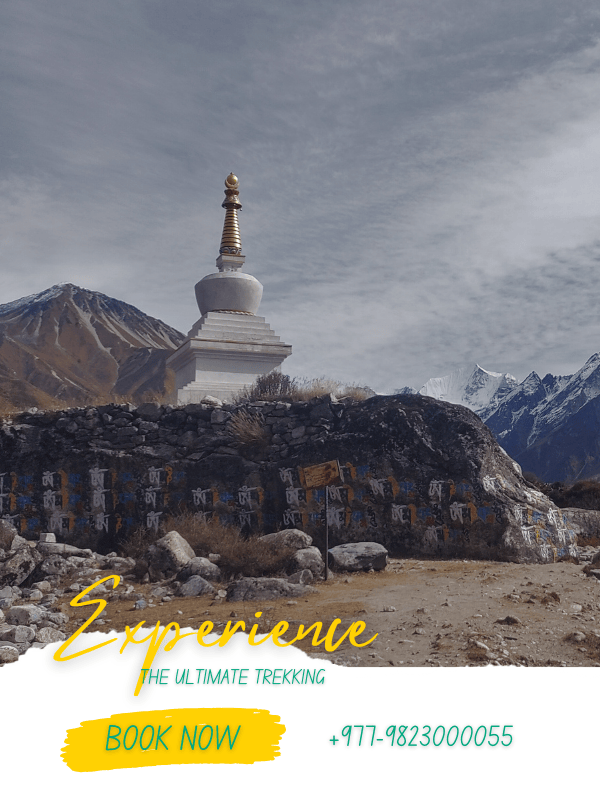
The Langtang Valley is situated in the Bagmati province of central Nepal, approximately 61.8 kilometers north of Kathmandu. It lies in the region where the southernmost limit of the Tibetan plateau meets the Himalayan mountain range. The valley's geographical coordinates are roughly 28.2° N latitude and 85.6° E longitude. The Langtang Valley is nestled between the main Himalayan range to the north, bordering Tibet, and a slightly lower range of snowy peaks to the south. Langtang Lirung (7,227 meters), Gang Chhenpo (6,388 meters), Naya Kanga Ri (5,846 meters), and Dorje Lakpa (6,966 meters) are some of the prominent peaks surrounding the valley. The highest point in the national park is Langtang Lirung.
The valley's geographical position holds significant scientific interest. It presents a unique opportunity to study tectonic and metamorphic processes due to its location along the tectonic boundary between the Indian and Eurasian plates. It's also a valuable site for studying glacial processes and the impact of climate change on the Himalayan ecosystem, given the prevalence of glaciers in the region. In terms of cultural geography, Langtang Valley is significant because it's home to the Tamang ethnic group, whose culture and traditions bear a strong resemblance to Tibetan society. This offers valuable insights into the historical migration and cultural exchange between Tibet and Nepal.
From a tourism perspective, Langtang's location near Kathmandu makes it easily accessible compared to other remote Himalayan regions. Despite its proximity to the capital, Langtang Valley provides a peaceful retreat from the hustle and bustle, offering tourists a blend of high-altitude adventure, natural beauty, and cultural immersion.
Langtang Valley Trek Costs
Langtang Valley Trek
USD 880 / Per Person- A private and customized trip.
- Private transfer from Kathmandu to Syabrubesi.
- Local lodge accommodation.
- Meals as mentioned in the itinerary.
- A trekking guide during the whole trip.
- All government taxes and fees.
A short cultural trek near Kathmandu that may be done in one week.
Download Trip DetailsLangtang Godaikunda Trek
USD 1300 / Per Person- A private and customized trip.
- Private transportation from Kathmandu to Syabrubesi.
- Local lodge accommodation.
- Meals as mentioned in the itinerary.
- A trekking guide during the whole trip.
- All government taxes and fees.
An extended trek to discover culture and nature near Kathmandu.
Download Trip DetailsThe cost of the Langtang Valley Trek varies on the mode of transportation (sharing or parivate), accommodation, group size and additional services offered in the trip package. Our packages range starts from USD 600 to USD 3000, which is either a group trip or a private trip upon your prefereces.
Langtang Valley Trek
Our Langtang Valley Trek is one of the most ideal treks near Kathmandu beginning and ending in Kathmandu that lasts for 6 days and offers a spectacular fusion of natural and cultural depth. The journey starts with a scenic drive from Kathmandu to Syabrubesi, the entry point to the Langtang region known for its picturesque scenery. Throughout this trek, you will walk through thick forests, high current rivers, and terraced farmlands, alongside the Tamnag and Sherpa villages where you will see the indigenous people's day-to-day life. These settlements are influenced by Tibetan culture as the region lies on the border with Tibet hence you will get to see the beautiful blend of these different cultures. This trek provides a close-up view of glaciers and waterfalls as well as breathtaking views of the snow-capped mountains such as Langtang Lirung. The Langtang valley is a vast high-altitude valley surrounded by sky-scraping peaks which becomes the focal point of the walk. This trek not only offers a peaceful walk to the mountains but also a rich cultural immersion along with a unique trekking experience in just 6 days. The valley offers tranquil villages for you to explore with a chance to see and learn about the historical monasteries and Gompas such as Kyanjin Gompa which has a long history that will surely fascinate you.
Additionally, this wonderful trek also presents thrilling activities for daredevils like peak climbing. People who are interested or are beginner peak climbers can go for Yala peak climbing which is a non-technical climb located close to Langtang Peak which is perfect for those who are new to mountaineering. Yala Peak standing at an elevation of 5,500 meters is a rather straightforward ascent that makes a great starting point for climbers wishing to expand their journey beyond trekking. Yala Peak provides a stunning panoramic view of the nearby Himalayan giants, including Shishapangma and Langtang Lirung. Langtang Valley offers a wide range of adventures making it ideal for adventure seekers regardless of advanced skills such as trekking or movie climber.
Langtang Valley Trek Attractions
Throughout the trek, you will get to see and experience lots of aspects from natural beauty to cultural exploration, and each will provide you with a unique trekking experience. you will see the beauty with your own eyes and explore the iconic Langtang Valley in depth. Some of the main attractions of Langtang Valley are listed below.
Langtang National Park
Langtang National Park situated on the northern side of Kathmandu is also the nearest trekking region from Kathmandu. Lying closer to the capital, Kathmandu, this region is easy yet wild. Langtang National Park is popular for its rich biodiversity, spectacular mountain vistas, and beautiful cultural heritage. As Nepal’s first Himalayan national park, it covers a vast area that includes snow-capped mountains, lush forests, and diverse wildlife making it one of the most popular trekking destinations from Kathmandu. The region is home to numerous flora and fauna among which are endangered species like the panda, Himalayan black bear, and snow leopard making it a heaven for those who are interested in wildlife. Besides the wildlife, you can also see pristine forests of oak, pine, and varieties of rhododendrons, along with glacial drivers and alpine meadows that offer a unique trekking experience. Additionally, the park is also a cultural treasure trove, with traditional Tamang and Sherpa villages that offer insight into Tibeatan-influenced lifestyle, architecture, and cultural practices. The combination of natural beauty, trekking opportunities, and cultural immersion makes Langtang National Park a popular and beloved destination for trekkers and adventurers seeking a blend of nature and culture.
Tamang Villages
Among popular attractions, Tamang village is one of them as the Langtang Valley has been home to Tamang people for generations. Throughout the Langtang Valley trek, you will get a glimpse into the traditional lifestyle of the Tamang people, who are of Tibetan descent. The villages such as Lama Hotel, and Ghora Tabela are situated amidst the stunning landscape of the valley surrounded by lush forests and towering peaks providing natural splendor. The Tamang people are known for their warm hospitality and rich cultural traditions, which are evident in their daily lives, festivals, and religious practices. While you are in the area you will see traditional wooden houses, adorned with beautiful carvings and colorful prayer flags that reflect Tibetan influences. The villages are often located around monasteries and Stupas, where Buddhist rituals and ceremonies are an important part of community life. You will experience authentic local cuisines and amazing locally made cheeses and if lucky get the chance to attend local gatherings. In addition to cultural experience, the village offers insight into sustainable mountain living and resilience, especially after the 2015 earthquake that impacted the region. The reconstruction efforts and ongoing community spirit highlight the strength and adaptability of the locals, making these villages a fascinating and enriching aspect of the Langtang Valley trek.
Situated in Langtang Valley, the Langtang Village Memorial is a heartbreaking and meaningful place that honors the lives lost after the horrific earthquake that devastated Nepal on April 25, 2015. The 7.8 magnitude earthquake resulted in a major avalanche that buried the community under a tremendous pile of ice and debris, killing numerous people and destroying buildings and infrastructures. Located in the former Langtang village, the memorial site honors people who lost their lives and represents hope and healing for the community’s remaining members. People who visit the memorial site pay their respect to the victims and honor the memory of the area which was the biggest village in the entire Langtang valley.
Nepal’s Langtang Valley is known for many things from its remarkable Himalayan landscape to its status as the origin of the country’s beloved yak cheese. Among many amazing things present in Langtang is the Cheese Factory which was established by a Swiss aid projection in the 1950s and has become renowned for producing high-quality cheese in a remote Himalayan region. Located in Kyanjin village it adds extra charm to the picaresque village. The cheese factory is a unique and popular attraction offering visitors a taste of locally produced yak cheese which is a delicacy of the place. The process of making this cheese which is a delicacy is so fascinating as it follows traditional methods using milk from yaks and Chauris (a cross of yak and cow) which thrive in the region's highly nutritious and high-altitude pastures full of rich herbs and grasses giving the process its distinctive flavor and freshness.
Kyanjin Gompa
Kyanjin Gompa is a wonderful village located in the Langtang Valley of Nepal, best known for its peaceful and spiritual significance. Situated at an elevation of around 3,500 meters above sea level, it is home to the natives and an ancient Tibetan Buddhist monastery, making it a pilgrimage site for both locals and travelers. The village offers a majestic view of the surrounding snow-capped mountains, including Langtang Lirung, and serves as a base camp for various short hikes in the region to the vantage viewpoints. Kyanjin Gompa is also known for its beautiful ambiance and local cheese factory as previously mentioned. Here you can observe the making of the local cheese and soak in the beautiful ambiance of village life. Kyanjin Gompa being the last human settlement of the Langtang Valley trek provides not just a resting spot but an unlimited opportunity for learning and relaxation as you can see the seamless blend of cultural heritage, spiritual tranquility, and breathtaking natural scenery making it one of the most popular destinations for those seeking adventure and peace in the Himalayas.
Kyangin Ri and Tserko Ri
During your Langtang Valley trek, you will come across two of the most beautiful viewpoints of the Langtang Valley which are Kyanjin Ri and Tserko Ri. These viewpoints provide spectacular views of the surroundings as Kyanjin Ri offers expansive views of the Langtang range and glacier, while TserkoRi located further along the trek, delivers sweeping vistas of the Langtang and Ganesh Himal ranges. Both points are known for their celestial scenery, making them key highlights for trekkers seeking to experience the marvel of the Langtang Valley. Kyanjin Ri is a popular viewpoint located above Kyanjin Gompa in the Langtang valley best known for its panoramic views of the surrounding Himalayan peak and the beautiful Kyanjin Gompa. Situated at an elevation of 4,773 meters above sea level is a relatively accessible peak with a grand view. The viewpoint provides a glorious visit to Langtang Lirung, Yala Peak, and Dorje Lakpa as well as the glacier. Next is Tserko Ri situated at an elevation of above 5,000 meters of sea level. It is another popular vantage point with a higher elevation and expansive panoramic view compared to Kyanjin Ri. Reaching this top can be quite challenging than reaching Kyanjin Ri due to its higher elevation and rough trail however the view from here is worth the challenge. Tserko Ri offers a border perspective of the Langtang region, including the mesmerizing view of the Ganesh Himal and distant peaks like Shishapangma. Unlike Kyanjin Ri, which primarily offers the Langtang range and nearby village, Tserko Ri provides a more extensive horizon, allowing you to see a wider array of mountain peaks and glaciers.
Langtang Lirung Glacier
The Langtang Lirung Glacier is another popular attraction that offers awe-inspiring beauty; it is closely located on the Langtang Valley trekking trail that offers travelers an up-close experience with one of the Himalayan’s magnificent natural wonders. It is situated in the Langtang valley beneath the towering Langtang Lirung Peak which stands at an elevation of 7,227 meters above sea level. The glacier showcases dramatic landscapes of the surroundings such as icefall, crevasses, and a bit of rugged terrain. When you pass through the valley you are treated to the breathtaking views of the massive glacier especially from Kyanjin Gompa, which also happens to be the last human settlement on the trek. The glacier is also known for its easy accessibility compared to other Himalayan glaciers allowing even moderate trekkers to witness its marvels without the need for any advanced climbing skills.
How difficult is the Langtang Valley Trek?
The Langtang Valley trek is known for its moderate difficulty, making it suitable for trekkers with decent physical fitness. The trek involves daily ascents and descents over different landscapes including forested paths, rocky trails, and alpine meadows to elevation up to 4,000 meters above sea level. Having to cover around 5-7 hours of hiking daily with gradual elevation gain as you move higher into the valley can be quite challenging, however the view and ambience will make your walk enjoyable. While the trail is well marked and not overly technical, the challenge lies in the increasing altitude, with Kyanjin Gompa situated at above 3,000 altitude and other viewpoints such as Kyanjin Ri and Tersko Ri at above 4,000m and 5,000m. As you go higher, altitude sickness can be a concern which can be a big obstacle for your trek. This trek is considered moderated level difficulty however every trek requires some level of stamina, as some sections can be steep and physically demanding. Regardless of the trek's difficulty, having good physical and mental health will be helpful for the trek. For a smooth journey proper pacing and preparation can be helpful as walking at a steady pace and staying hydrated can make the trek more enjoyable and manageable.
Best Time to Visit
The best time to visit the Langtang Valley trek is during the pre-monsoon (spring) and post-monsoon (autumn) seasons. These two seasons are the ideal time for trekking as in spring, which is from March to May, the weather is mild and the trail is full of vibrant blooming rhododendrons, making it look dreamy with beautiful colors of nature. During this time of year, the skies are generally clear, offering a clear view of the region and surrounding peaks. The temperature during this time becomes perfect for outdoor activities such as trekking making your walk even more pleasant. Next is Autumn which starts from September to November which is another perfect time for trekking, with crisp, clear skies and stable weather conditions after the summer rains. The post-monsoon air provides spectacular mountain vistas and the temperature is moderate, making the walk comfortable. During this time the vibe is brilliant as around this time of the year, the festive season of Nepal begins providing you a chance to see and experience the local tradition and vibrant cultural colors.
Besides that winter (December to February) is cold, especially at the higher elevation, and nighttime makes your stay a bit uncomfortable, however the trails are less crowded and the landscapes are covered in pristine white snow adding a unique beauty. Next is the monsoon season (June to August) which brings heavy rain, and a few slippery trails making it the least favorable time for trekking, however the valley is lush and green providing an unique experience during this time. These two are not the most popular times for trekking; they do provide a unique trekking experience.
Conclusion
The Langtang Valley trek concludes as a truly beautiful journey that seamlessly blends mesmerizing natural beauty with deep cultural immersion. Over six days of Langtang Valley trek you will be treated to a captivating array of experiences, from lush green forests, high altitude landscapes, culturally and spiritually rich traditional villages, and glorious views of the mountains. The trek leads you to the Kyanjin Gompa which is your final destination where you will get to see the ancient Tibetan-influenced monastery, traditional cheese factory, and spectacular close-up mountain views. Besides these, you will also visit the vantage point of the region where you will be able to see beyond the valley and even the expansive glaciers and unique landscape of the region. This trek is not just a journey to the mountains but a journey to several unique experiences as you will be treated to opportunities for peak climbing, historical exploration, and a relaxing outdoor adventure. Throughout the trip, you will visit numerous beautiful and historical places such as traditional Tamang and Sherpa villages and Langtang village memorials showcasing the resilience and strong spirit of the people. Whether exploring the panoramic vistas from Kyanjin Ri or witnessing the brilliant Langtang Lirung Glacier, you are sure to leave with a deep appreciation for the spectacular corner of the Himalayas.
